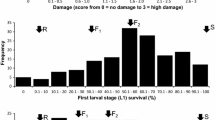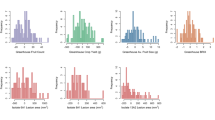Abstract
A novel source of resistance to two-spotted spider mite (Tetranychus urticae Koch) was found in Solanum pimpinellifolium L. accession TO-937 and thereby a potential source of desirable traits that could be introduced into new tomato varieties. This resistance was found to be controlled by a major locus modulated by minor loci of unknown location in the genome of this wild tomato. We first applied a bulked segregant analysis (BSA) approach in an F4 population as a method for rapidly identifying a genomic region of 17 cM on chromosome 2, flanked by two simple sequence repeat markers, harboring Rtu2.1, one of the major QTL involved in the spider mite resistance. A population of 169 recombinant inbred lines was also evaluated for spider mite infestation and a highly saturated genetic map was developed from this population. QTL mapping corroborated that chromosome 2 harbored the Rtu2.1 QTL in the same region that our previous BSA findings pointed out, but an even more robust QTL was found in the telomeric region of this chromosome. This QTL, we termed Rtu2.2, had a LOD score of 15.43 and accounted for more than 30 % of the variance of two-spotted spider mite resistance. Several candidate genes involved in trichome formation, synthesis of trichomes exudates and plant defense signaling have been sequenced. However, either the lack of polymorphisms between the parental lines or their map position, away from the QTL, led to their rejection as candidate genes responsible for the two-spotted spider mite resistance. The Rtu2 QTL not only serve as a valuable target for marker-assisted selection of new spider mite-resistant tomato varieties, but also as a starting point for a better understanding of the molecular genetic functions underlying the resistance to this pest.




Similar content being viewed by others
References
Alba JM, Montserrat M, Fernandez-Munoz R (2009) Resistance to the two-spotted spider mite (Tetranychus urticae) by acylsucroses of wild tomato (Solanum pimpinellifolium) trichomes studied in a recombinant inbred line population. Exp Appl Acarol 47:35–47
Alpert KB, Grandillo S, Tanksley SD (1995) Fw-2.2: a major QTL controlling fruit weight is common to both red-fruited and green-fruited tomato species. Theor Appl Genet 91:994–1000
Areshchenkova T, Ganal MW (1999) Long tomato microsatellites are predominantly associated with centromeric regions. Genome 42:536–544
Bernacchi D, Tanksley SD (1997) An interspecific backcross of Lycopersicon esculentum × L. hirsutum: linkage analysis and a QTL study of sexual compatibility factors and floral traits. Genetics 147:861–877
Blauth SL, Churchill GA, Mutschler MA (1998) Identification of quantitative trait loci associated with acylsugar accumulation using intraspecific populations of the wild tomato, Lycopersicon pennellii. Theor Appl Genet 96:458–467
Blauth SL, Steffens JC, Churchill GA, Mutschler MA (1999) Identification of QTLs controlling acylsugar fatty acid composition in an intraspecific population of Lycopersicon pennellii (Corr.) D’Arcy. Theor Appl Genet 99:373–381
Burr B, Burr FA (1991) Recombinant inbreds for molecular mapping in maize. Trends Genet 7:55–60
Carter CD, Snyder JC (1985) Mite Responses in relation to trichomes of L. esculentum × hirsutum F2 hybrids. Euphytica 34:177–185
Chatzivasileiadis EA, Sabelis MW (1997) Toxicity of methyl ketones from tomato trichomes to Tetranychus urticae Koch. Exp Appl Acarol 21:473–484
Fernandez-Muñoz R, Dominguez E, Cuartero J (2000) A novel source of resistance to the two-spotted spider mite in Lycopersicon pimpinellifolium (Jusl.) Mill.: its genetics as affected by interplot interference. Euphytica 111:169–173
Fernandez-Muñoz R, Salinas M, Alvarez M, Cuartero J (2003) Inheritance of resistance to two-spotted spider mite and glandular leaf trichomes in wild tomato Lycopersicon pimpinellifolium (Jusl.) Mill. J Am Soc Hortic Sci 128:188–195
Foolad MR (2007) Genome mapping and molecular breeding of tomato. Int J Plant Genomics 2007:64358
Frary A, Nesbitt TC, Frary A, Grandillo S, van der Knaap E, Cong B, Liu J, Meller J, Elber R, Alpert KB, Tanksley SD (2000) fw2.2: a quantitative trait locus key to the evolution of tomato fruit size. Science 289:85–88
Fulton TM, Van der Hoeven R, Eannetta NT, Tanksley SD (2002) Identification, analysis, and utilization of conserved ortholog set markers for comparative genomics in higher plants. Plant Cell 14:1457–1467
Gatehouse JA (2002) Plant resistance towards insect herbivores: a dynamic interaction. New Phytol 156:145–169
Guo Z, Weston PA, Snyder JC (1993) Repellency to two-spotted spider mite Tetranychus urticae Koch, as related to leaf surface chemistry of Lycopersicon hirsutum accessions. J Chem Ecol 19:2965–2979
Jahangir K, Van Thomas L, Maria G, Evangelia M, Haoués A, Mylène W, Luc T, John V, Anastasia T (2010) Acetylcholinesterase point mutations in European strains of Tetranychus urticae (Acari: Tetranychidae) resistant to organophosphates. Pest Manage Sci 66:220–228
Jansen RC, Stam P (1994) High resolution of quantitative traits into multiple loci via interval mapping. Genetics 136:1447–1455
Kang JH, Liu G, Shi F, Jones AD, Beaudry RM, Howe GA (2010) The Tomato odorless-2 mutant is defective in trichome-based production of diverse specialized metabolites and broad-spectrum resistance to insect herbivores. Plant Physiol 154:262–272
Koo AJK, Howe GA (2009) The wound hormone jasmonate. Phytochemistry 70:1571–1580
Kosambi DD (1944) The estimation of map distances from recombination values. Ann Eugenics 12:172–175
Lemke CA, Mutschler MA (1984) Inheritance of glandular trichomes in crosses between Lycopersicon esculentum and Lycopersicon pennellii. J Am Soc Hortic Sci 109:592–596
Li L, Zhao Y, McCaig BC, Wingerd BA, Wang J, Whalon ME, Pichersky E, Howe GA (2004) The tomato homolog of CORONATINE-INSENSITIVE1 is required for the maternal control of seed maturation, jasmonate-signaled defense responses, and glandular trichome development. Plant Cell 16:126–143
Li HH, Ye GY, Wang JK (2007) A modified algorithm for the improvement of composite interval mapping. Genetics 175:361–374
Maluf WR, Maciel GM, Gomes LAA, Cardoso MD, Goncalves LD, da Silva EC, Knapp M (2010) Broad-spectrum arthropod resistance in hybrids between high- and low-acylsugar tomato lines. Crop Sci 50:439–450
McDowell ET, Kapteyn J, Schmidt A, Li C, Kang J-H, Descour A, Shi F, Larson M, Schilmiller A (2011) Comparative functional genomic analysis of solanum glandular trichome types. Plant Physiol 155:524–539
Michelmore RW, Paran I, y Kesseli RV (1991) Identification of markers linked to disease-resistance genes by bulked segregant analysis: a rapid method to detect markers in specific genomic regions by using segregating populations. Proc Natl Acad Sci USA 88:9828–9832
Monforte AJ, Tanksley SD (2000) Development of a set of near isogenic and backcross recombinant inbred lines containing most of the Lycopersicon hirsutum genome in a L. esculentum genetic background: a tool for gene mapping and gene discovery. Genome 43:803–813
Montgomery J, Wittwer CT, Palais R, Zhou LM (2007) Simultaneous mutation scanning and genotyping by high-resolution DNA melting analysis. Nat Protoc 2:59–66
Paterson AH, DeVerna JW, Lanini B, Tanksley SD (1990) Fine mapping of quantitative trait loci using selected overlapping recombinant chromosomes, in an interspecies cross of tomato. Genetics 124:735–742
Paterson AH, Damon S, Hewitt JD, Zamir D, Rabinowitch HD, Lincoln SE, Lander ES, Tanksley SD (1991) Mendelian factors underlying quantitative traits in tomato: comparison across species, generations, and environments. Genetics 127:181–197
Resende JTV, Maluf WR, MdG Cardoso, Nelson DL, Faria MV (2002) Inheritance of acylsugar contents in tomatoes derived from an interspecific cross with the wild tomato Lycopersicon pennellii and their effect on spider mite repellence. Genet Mol Res 1:106–116
Rick CM (1979) Biosystematic studies in Lycopersicon and closely related species of Solanum. In: Hawkes JG, Lester RN, Skelding AD (eds) The biology and taxonomy of the solanaceae. Academic press, New York, pp 667–678
Saeidi Z, Mallik B, Kulkarni RS (2007) Inheritance of glandular trichomes and two-spotted spider mite resistance in cross Lycopersicon esculentum “Nandi” and L pennellii “LA2963”. Euphytica 154:231–238
Schilmiller AL, Miner DP, Larson M, McDowell E, Gang DR, Wilkerson C, Last RL (2010) Studies of a biochemical factory: tomato trichome deep expressed sequence tag sequencing and proteomics. Plant Physiol 153:1212–1223
Simmons AT, Gurr GM (2005) Trichomes of Lycopersicon species and their hybrids: effects in pests and natural enemies. Agr Forest Entomol 7:265–276
Slocombe SP, Schauvinhold I, McQuinn RP, Besser K, Welsby NA, Harper A, Aziz N, Li Y, Larson TR, Giovannoni J, Dixon RA, Broun P (2008) Transcriptomic and reverse genetic analyses of branched-chain fatty acid and acyl sugar production in Solanum pennellii and Nicotiana benthamiana. Plant Physiol 148:1830–1846
Smulders MJM, Bredemeijer G, RusKortekaas W, Arens P, Vosman B (1997) Use of short microsatellites from database sequences to generate polymorphisms among Lycopersicon esculentum cultivars and accessions of other Lycopersicon species. Theor Appl Genet 94:264–272
Snyder JC, Thacker RR, Zhang X (2005) Genetic transfer of a two-spotted spider mite (Acari: Tetranychidae) repellent in tomato hybrids. J Econ Entomol 98:1710–1716
Stamova BS, Chetelat RT (2000) Inheritance and genetic mapping of cucumber mosaic virus resistance introgressed from Lycopersicon chilense into tomato. Theor Appl Genet 101:527–537
Stenzel I, Hause B, Maucher H, Pitzschke A, Miersch O, Ziegler J, Ryan CA, Wasternack C (2003) Allene oxide cyclase dependence of the wound response and vascular bundle-specific generation of jasmonates in tomato: amplification in wound signalling. Plant J 33:577–589
The Tomato Genome Consortium (2012) The tomato genome sequence provides insights into fleshy fruit evolution. Nature 485:635–641
Tomczyk A, Kropczynska D (1985) Effects on the host plant. In: Helle W, Sabelis MW (eds) Spider mites their biology, natural enemies and control. World crop pests. Elsevier, Amsterdam, pp 317–329
Van Leeuwen T, Tirry L (2007) Esterase-mediated bifenthrin resistance in a multiresistant strain of the two-spotted spider mite, Tetranychus urticae. Pest Manage Sci 63:150–156
Van Leeuwen T, Van Pottelberge S, Tirry L (2005) Comparative acaricide susceptibility and detoxifying enzyme activities in field-collected resistant and susceptible strains of Tetranychus urticae. Pest Manage Sci 61:499–507
Van Ooijen JW (2004) MapQTL 5, Software for the Mapping of quantitative trait loci in experimental populations. Kyazma BV Wageningen, the Netherlands
Van Ooijen JW (2006) JoinMap Version 4.0, Software for the calculation of genetic linkage maps. Kyazma BV Wageningen, The Netherlands
Villalta I, Reina-Sanchez A, Cuartero J, Carbonell EA, Asins MJ (2005) Comparative microsatellite linkage analysis and genetic structure of two populations of F6 lines derived from Lycopersicon pimpinellifolium and Lycopersicon cheesmanii. Theor Appl Genet 110:881–894
Voorrips RE (2002) Mapchart: software for the graphical presentation of linkage maps and QTLs. J Hered 93:77–78
Yang C, Li H, Zhang J, Wang T, Ye Z (2011) Fine-mapping of the woolly gene controlling multicellular trichome formation and embryonic development in tomato. Theor Appl Genet 123:625–633
Acknowledgments
We are grateful to Fernando J. Yuste for his support with mapping approaches. This research was supported by the Spanish Ministerio de Ciencia e Innovación (AGL2007-66760-C02 project) and cofounded by EU through FEDER program. M.S. was a recipient of FPU predoctoral fellowship and B.M. is a recipient of a FPI predoctoral fellowship from the Ministerio de Ciencia e Innovación. We also thank Junta de Andalucía for financial support to our research groups AGR-129 (IHSM) and AGR-176 (UAL).
Author information
Authors and Affiliations
Corresponding author
Additional information
Communicated by I. Paran.
M. Salinas and C. Capel contributed equally to this work.
Rights and permissions
About this article
Cite this article
Salinas, M., Capel, C., Alba, J.M. et al. Genetic mapping of two QTL from the wild tomato Solanum pimpinellifolium L. controlling resistance against two-spotted spider mite (Tetranychus urticae Koch). Theor Appl Genet 126, 83–92 (2013). https://doi.org/10.1007/s00122-012-1961-0
Received:
Accepted:
Published:
Issue Date:
DOI: https://doi.org/10.1007/s00122-012-1961-0




